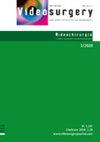Effect and prognosis of endoscopic intracranial hematoma removal and hematoma puncture and drainage in patients with hypertensive intracerebral hemorrhage
IF 1.9
4区 医学
Q2 SURGERY
引用次数: 0
Abstract
IntroductionHypertensive intracerebral hemorrhage is one of the most serious complications of hypertension. The treatment focuses on reducing bleeding damage and promoting functional recovery.
Aim
This study investigated the efficacy and prognosis of endoscopic intracranial hematoma removal (EIHR) and hematoma puncture and drainage (HPD) in treating hypertensive intracerebral hemorrhage (HICH).
Material and methods
Ninety-two patients admitted to our hospital for EIHR and HPD between September 30, 2021 and September 30, 2022 were enrolled, including 14 cases of EIHR (endoscopy group) and 78 cases of HPD (puncture group). The efficacy of the two surgery modes in treating HICH patients was compared. Univariate logistic regression (ULR) and multivariate logistic regression (MLR) were employed to analyze the influences of different treatment methods on the prognosis of patients with HICH.
Results
The average hematoma clearance rate (HCR) of all patients was 80.52%, and the patients in the endoscopy group had a higher HCR than those in the puncture group (73.00% vs. 86.00%) (p < 0.001). The good prognosis rate (GPR) shown by the Glasgow Outcome Scale (GOS) score in the endoscopy group was 69.23%, and that in the puncture group was 40.38%, a large but statistically non-significant difference (p > 0.05).
Conclusions
The HCR of EIHR was greatly higher based on that of HPD, but showed no great difference in prognostic effect. The higher the GCS score on admission, the lower the likelihood of poor prognosis.
内镜下颅内血肿清除术和血肿穿刺引流术对高血压性脑出血患者的影响和预后
导言高血压脑出血是高血压最严重的并发症之一,治疗重点是减少出血损伤和促进功能恢复。目的 探讨内镜下颅内血肿清除术(EIHR)和血肿穿刺引流术(HPD)治疗高血压性脑出血(HICH)的疗效和预后。材料与方法选取2021年9月30日至2022年9月30日期间我院收治的92例EIHR和HPD患者作为研究对象,其中EIHR(内镜组)14例,HPD(穿刺组)78例。比较了两种手术方式治疗 HICH 患者的疗效。结果所有患者的平均血肿清除率(HCR)为80.52%,内镜组患者的HCR高于穿刺组(73.00% vs. 86.00%)(P <0.001)。结论 EIHR的HCR在HPD的基础上大大提高,但在预后效果上没有太大差异。入院时 GCS 评分越高,预后不良的可能性越低。
本文章由计算机程序翻译,如有差异,请以英文原文为准。
求助全文
约1分钟内获得全文
求助全文
来源期刊
CiteScore
2.80
自引率
23.50%
发文量
48
审稿时长
12 weeks
期刊介绍:
Videosurgery and other miniinvasive techniques serves as a forum for exchange of multidisciplinary experiences in fields such as: surgery, gynaecology, urology, gastroenterology, neurosurgery, ENT surgery, cardiac surgery, anaesthesiology and radiology, as well as other branches of medicine dealing with miniinvasive techniques.

 求助内容:
求助内容: 应助结果提醒方式:
应助结果提醒方式:


